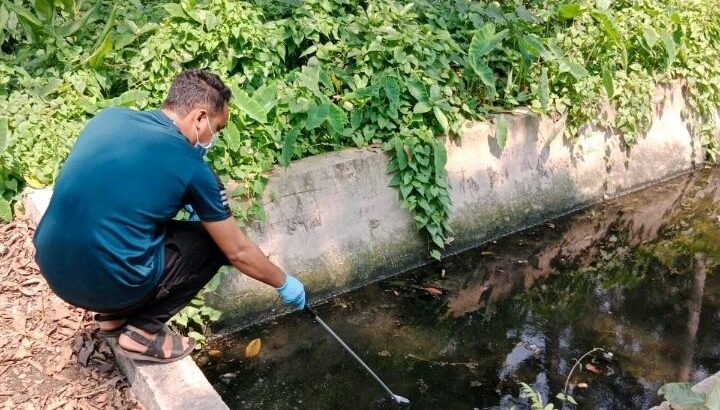Typhoid, caused by the bacterium Salmonella Typhi (S. Typhi), is notoriously difficult and expensive to diagnose. The gold standard diagnostic is blood culture confirmation, which is often unavailable at community health facilities in low-and middle-income countries. Although S. Typhi can be detected in water bodies, the resources and time needed to collect and test water samples are also unavailable in most communities. Recent studies conducted in Bangladesh and Nepal found an alternative technique to trace typhoid bacteria by detecting bacteriophages, or phage viruses, in water bodies.
Bacteriophages, or “phages,” are viruses that infect specific bacteria. Like any other virus, phages need a host to survive and reproduce. They infect a specific bacterium and inject their DNA. The DNA replicates to produce more phages and eventually the bacterium explodes, releasing more phages that infect more bacteria. If more “killer”, or infecting, phages are found in the environment, that means there are more “host” typhoid bacteria upon which to prey.
In honor of World Environmental Day, we take a deep dive into the approach of scanning wastewater to identify phages as one means to locate typhoid hotspots.
Dr. Senjuti Saha, director and scientist at the Child Health Research Foundation in Bangladesh, is one of the researchers exploring what phages can tell us about typhoid. We spoke with her to learn about the importance of bacteriophages in the environment and why rapid environmental surveillance helps typhoid detection.
How did scientists first discover the correlation between phages and the level of typhoid bacteria in the water?
We collected environmental water samples from two different regions in Bangladesh: Dhaka, an urban area with high typhoid burden, and Mirzapur, a rural area with low typhoid burden. We tested water samples from each of these areas and found that water samples from Dhaka were more likely to have phages specific to typhoid bacteria. This suggested that phage positivity of different water samples collected from different geographical areas might correlate with the levels of typhoid bacteria in water. This was first started as a collaborative effort between the Child Health Research Foundation and Stanford University, which found similar results in Nepal during the same time.
What are the advantages of testing water for bacteriophages rather than for typhoid bacteria?
Typhoid bacteria are present at very low levels in water samples. Also, for reasons not well understood, it is very hard to culture typhoid bacteria directly from water sources. Molecular methods have been used to detect typhoid bacterial DNA. However, these methods did not work very efficiently and do not provide information on live bacteria. Bacteriophages are often more abundant than bacteria and they can be rapidly amplified by culturing with their bacterial host. These two properties make bacteriophage surveillance more sensitive and robust. Additionally, bacteriophage surveillance does not require any costly equipment (PCR machines, kits) or infrastructure; the cost per sample is very low, allowing it to be rolled out in low-resource settings.
What are the limitations of testing phages instead of typhoid bacteria?
The primary limitation is that we cannot obtain any molecular information about the circulating typhoid bacteria. We cannot determine the circulating genotypes, or obtain direct information related to the drug resistance genes that may be present.
How can investigating phage viruses predict the routes, spots, and seasonal spread of typhoid?
It would depend on the setting. In low-endemic settings, the detection of phages might indicate a potential outbreak or the presence of asymptomatic carriers. It is possible that by sampling various positions in the sewage network we might be able to identify these carriers and employ non-pharmaceutical interventions (safe water, handwashing) to prevent outbreaks before they happen.
For highly endemic settings, we can imagine identifying points of contamination for drinking water supplies, testing surface waters (ponds, rivers) safe for human use, or even investigating the impact of interventions such as improved water, sanitation, and hygiene (WASH), or typhoid conjugate vaccines (TCV) on the community.
For seasonal dynamics, further work is needed to understand the dynamics of phage-typhoid bacteria before we can make strong inferences.
What role does environmental water surveillance have in measuring typhoid burden and preventing typhoid as we confront climate change?
Climate change is likely to increase flooding in several countries where typhoid is endemic. In such cases, having a low-cost surveillance method for detecting typhoid bacteria in environmental water will be crucial for early detection of typhoid cases and implementation of strategies to mitigate the risk.
How would you like to see countries adapt/adopt this approach to influence health priorities, including new vaccine introduction?
We would like to see more researchers using this approach for generating data on typhoid burden. In many countries in Africa, typhoid rates are already high or increasing. However, limited data are available from these countries. We hope this method is easy to implement and can be used to generate preliminary data on typhoid burden. This could identify potential countries for TCV introduction. It could also help pinpoint sources of contamination and risk of transmission. This tool can also be used for rapid assessment of interventions like WASH and vaccines.
This approach also applies in high-income countries that see travel-related typhoid outbreaks. Such methods could be useful in identifying potential sources of contamination before multiple patients show up at the hospital. Given the ever-increasing occurrence of drug-resistant typhoid bacteria, such methods could help ensure high-income countries keep typhoid controlled. It is also of scientific interest to see how prevalent such phages are in high-income cities, and how often these cities identify typhoid carriers. We live in a globalized world and bacteriophages are everywhere; we just do not see them because we are not looking for them.
Photo: A researcher collects water samples in Bangladesh. Credit: Child Health Research Foundation Bacteriophage Team.



